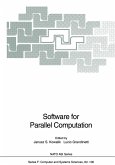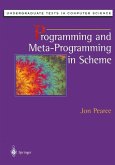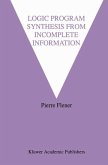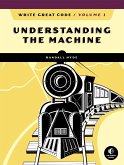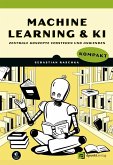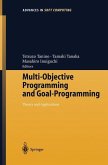- Broschiertes Buch
- Merkliste
- Auf die Merkliste
- Bewerten Bewerten
- Teilen
- Produkt teilen
- Produkterinnerung
- Produkterinnerung
Scheme provides a flexible and powerful language for programming embodying many of the best features of logical and functional programming. This enjoyable book provides readers with an introduction to programming in Scheme by constructing a series of interesting and re-usable programs. The book includes two diskettes containing MIT Scheme to run on Windows PCs.
Andere Kunden interessierten sich auch für
![Software for Parallel Computation Software for Parallel Computation]() KowalikSoftware for Parallel Computation77,99 €
KowalikSoftware for Parallel Computation77,99 €![Programming and Meta-Programming in Scheme Programming and Meta-Programming in Scheme]() Jon PearceProgramming and Meta-Programming in Scheme38,99 €
Jon PearceProgramming and Meta-Programming in Scheme38,99 €![Logic Program Synthesis from Incomplete Information Logic Program Synthesis from Incomplete Information]() Pierre FlenerLogic Program Synthesis from Incomplete Information115,99 €
Pierre FlenerLogic Program Synthesis from Incomplete Information115,99 €![Write Great Code, Volume 1 Write Great Code, Volume 1]() Randall HydeWrite Great Code, Volume 127,99 €
Randall HydeWrite Great Code, Volume 127,99 €![Machine Learning und KI kompakt Machine Learning und KI kompakt]() Sebastian RaschkaMachine Learning und KI kompakt34,90 €
Sebastian RaschkaMachine Learning und KI kompakt34,90 €![The Art of Machine Learning The Art of Machine Learning]() Norman MatloffThe Art of Machine Learning27,99 €
Norman MatloffThe Art of Machine Learning27,99 €![Multi-Objective Programming and Goal Programming Multi-Objective Programming and Goal Programming]() Tetsuzo Tanino / Tamaki Tanaka / Masahiro Inuiguchi (eds.)Multi-Objective Programming and Goal Programming160,49 €
Tetsuzo Tanino / Tamaki Tanaka / Masahiro Inuiguchi (eds.)Multi-Objective Programming and Goal Programming160,49 €-
-
-
Scheme provides a flexible and powerful language for programming embodying many of the best features of logical and functional programming. This enjoyable book provides readers with an introduction to programming in Scheme by constructing a series of interesting and re-usable programs. The book includes two diskettes containing MIT Scheme to run on Windows PCs.
Produktdetails
- Produktdetails
- Verlag: Springer / Springer New York / Springer, Berlin
- Artikelnr. des Verlages: 978-0-387-94681-8
- 1996.
- Seitenzahl: 256
- Erscheinungstermin: 25. April 1996
- Englisch
- Abmessung: 254mm x 178mm x 15mm
- Gewicht: 476g
- ISBN-13: 9780387946818
- ISBN-10: 0387946810
- Artikelnr.: 24484689
- Herstellerkennzeichnung
- Springer-Verlag GmbH
- Tiergartenstr. 17
- 69121 Heidelberg
- ProductSafety@springernature.com
- Verlag: Springer / Springer New York / Springer, Berlin
- Artikelnr. des Verlages: 978-0-387-94681-8
- 1996.
- Seitenzahl: 256
- Erscheinungstermin: 25. April 1996
- Englisch
- Abmessung: 254mm x 178mm x 15mm
- Gewicht: 476g
- ISBN-13: 9780387946818
- ISBN-10: 0387946810
- Artikelnr.: 24484689
- Herstellerkennzeichnung
- Springer-Verlag GmbH
- Tiergartenstr. 17
- 69121 Heidelberg
- ProductSafety@springernature.com
Mark Watson has been a professional developer for over a decade. His clients include the Department of Defense and other federal agencies, Pacific Bell, Nintendo, Disney, and Lutris Technologies. Mark has written 13 books for Hungry Minds, Morgan Kaufman, Springer Verlag, Sams, McGraw-Hill, and Wiley on topics ranging from artificial intelligence to Java programming for Windows.
1 Introduction.- 2 Tutorial Introduction to Scheme.- 2.1 Lists.- 2.2 Vectors.- 2.3 Logical tests.- 2.4 Defining local variables.- 2.5 Defining functions.- 2.6 Miscellaneous Scheme utility functions.- 3 Designing for Reuse.- 3.1 Modularity.- 3.2 Cohesion in function libraries.- 3.3 Loose coupling between library modules.- 3.4 Example: a library for genetic algorithms.- 3.5 Example application: allocating resources for sales and marketing.- 4 Writing Portable Scheme Code.- 4.1 Designing for portability.- 4.2 Isolating operating system and graphics code.- 4.3 A portable graphics library.- 4.4 Example library for displaying graph structures.- 4.5 Example: plotting Mandelbrot sets.- 4.6 Example: plotting chaotic population growth.- 5 An Iterative Approach to Analysis, Design, and Implementation.- 5.1 Preliminary analysis, design, and implementation of a network search program.- 5.2 Evaluation of the first implementation of the network search program.- 5.3 Improving our analysis, design, and implementation.- 6 Neural Network Library.- 6.1 Requirements for a neural network library.- 6.2 Design of a neural network library.- 6.3 Implementation of a neural network library.- 6.4 Example application: character recognition.- 7 Complex Data Structures.- 7.1 Using Scheme effectively to prototype and test complex data structures.- 7.2 Example application: natural language processing.- 8 Chess Playing Program.- 8.1 Analysis.- 8.2 Design.- 8.3 Implementation.- 9 Go Playing Program.- 9.1 Requirements and analysis.- 9.2 Module architecture.- 9.3 Interactively prototyping data structures.- 9.4 Low level Scheme functions to manipulate Go data structures.- 9.5 Go program design.- 9.6 Go program implementation.- 9.7 Ideas for improving the Go playing program.- Appendix A Installing and Runningthe MIT Scheme System.- Appendix B More Information Available on the Internet.
1 Introduction.- 2 Tutorial Introduction to Scheme.- 2.1 Lists.- 2.2 Vectors.- 2.3 Logical tests.- 2.4 Defining local variables.- 2.5 Defining functions.- 2.6 Miscellaneous Scheme utility functions.- 3 Designing for Reuse.- 3.1 Modularity.- 3.2 Cohesion in function libraries.- 3.3 Loose coupling between library modules.- 3.4 Example: a library for genetic algorithms.- 3.5 Example application: allocating resources for sales and marketing.- 4 Writing Portable Scheme Code.- 4.1 Designing for portability.- 4.2 Isolating operating system and graphics code.- 4.3 A portable graphics library.- 4.4 Example library for displaying graph structures.- 4.5 Example: plotting Mandelbrot sets.- 4.6 Example: plotting chaotic population growth.- 5 An Iterative Approach to Analysis, Design, and Implementation.- 5.1 Preliminary analysis, design, and implementation of a network search program.- 5.2 Evaluation of the first implementation of the network search program.- 5.3 Improving our analysis, design, and implementation.- 6 Neural Network Library.- 6.1 Requirements for a neural network library.- 6.2 Design of a neural network library.- 6.3 Implementation of a neural network library.- 6.4 Example application: character recognition.- 7 Complex Data Structures.- 7.1 Using Scheme effectively to prototype and test complex data structures.- 7.2 Example application: natural language processing.- 8 Chess Playing Program.- 8.1 Analysis.- 8.2 Design.- 8.3 Implementation.- 9 Go Playing Program.- 9.1 Requirements and analysis.- 9.2 Module architecture.- 9.3 Interactively prototyping data structures.- 9.4 Low level Scheme functions to manipulate Go data structures.- 9.5 Go program design.- 9.6 Go program implementation.- 9.7 Ideas for improving the Go playing program.- Appendix A Installing and Runningthe MIT Scheme System.- Appendix B More Information Available on the Internet.



